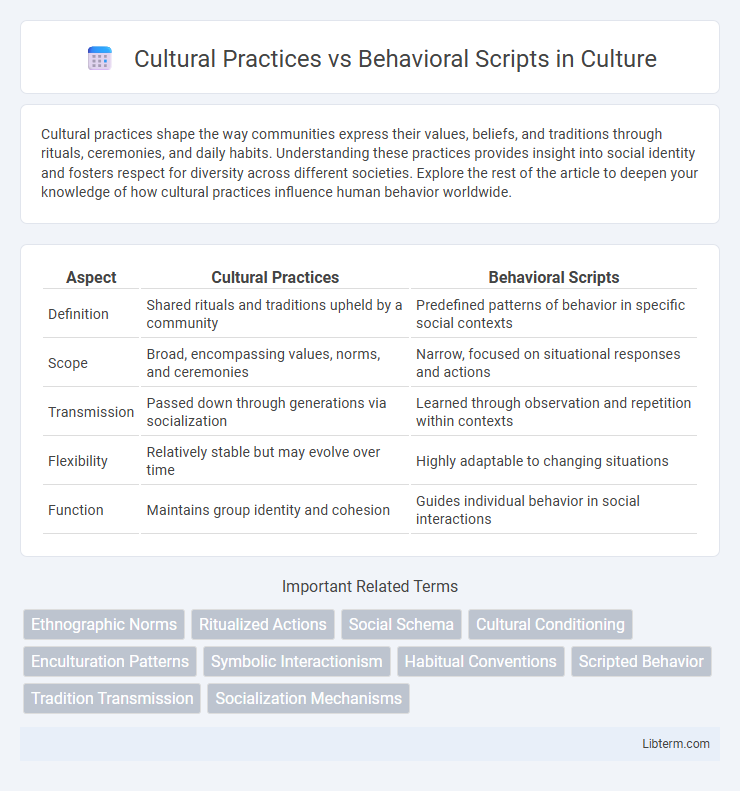Cultural practices shape the way communities express their values, beliefs, and traditions through rituals, ceremonies, and daily habits. Understanding these practices provides insight into social identity and fosters respect for diversity across different societies. Explore the rest of the article to deepen your knowledge of how cultural practices influence human behavior worldwide.
Table of Comparison
| Aspect | Cultural Practices | Behavioral Scripts |
|---|---|---|
| Definition | Shared rituals and traditions upheld by a community | Predefined patterns of behavior in specific social contexts |
| Scope | Broad, encompassing values, norms, and ceremonies | Narrow, focused on situational responses and actions |
| Transmission | Passed down through generations via socialization | Learned through observation and repetition within contexts |
| Flexibility | Relatively stable but may evolve over time | Highly adaptable to changing situations |
| Function | Maintains group identity and cohesion | Guides individual behavior in social interactions |
Understanding Cultural Practices
Understanding cultural practices involves recognizing shared traditions, rituals, and social norms that define a community's identity and influence group behavior. These practices are deeply embedded in historical contexts and provide a framework for interpreting social interactions, shaping values and expectations across generations. Analyzing cultural practices offers critical insights into how collective meanings are constructed and maintained within societies.
Defining Behavioral Scripts
Behavioral scripts are cognitive frameworks that guide individuals' actions in specific social situations by outlining expected sequences of behaviors. These scripts shape how people interpret social cues and respond consistently within cultural contexts. Unlike broader cultural practices, behavioral scripts provide detailed, situation-specific instructions that facilitate predictable and efficient social interactions.
Historical Contexts of Cultural Practices
Historical contexts of cultural practices reveal deeply rooted traditions shaped by centuries of social, political, and environmental factors. These practices often embody collective memory and identity, influencing customs, rituals, and social norms that are transmitted across generations. Behavioral scripts, by contrast, are more dynamic and context-dependent, serving as flexible guidelines for individual actions within the framework of these enduring cultural narratives.
The Psychology Behind Behavioral Scripts
Behavioral scripts are psychological frameworks that guide individuals' actions in specific social situations by internalizing cultural norms and expectations. These scripts allow for efficient decision-making and predictability in behavior, facilitating social interactions based on learned patterns. The psychology behind behavioral scripts involves cognitive processes such as memory encoding and retrieval, which help individuals anticipate consequences and conform to culturally appropriate actions.
Comparing Cultural Norms and Behavioral Patterns
Cultural practices represent the collective norms and values shared by a community, shaping broad societal behavior over time. Behavioral scripts are specific, context-driven patterns individuals follow within cultural frameworks, guiding daily interactions and decision-making. Comparing cultural norms and behavioral patterns reveals how generalized societal expectations translate into routine actions, influencing both individual conduct and group dynamics.
How Cultural Practices Shape Behavior
Cultural practices significantly influence behavior by establishing shared norms, values, and rituals that guide individuals' actions within a community. These practices serve as frameworks for behavioral scripts, providing predictable patterns for social interactions, decision-making, and problem-solving. The internalization of cultural norms through practices such as language use, ceremonies, and social conventions shapes cognitive processes and reinforces group identity, ultimately molding both individual and collective behavior.
The Role of Socialization in Behavioral Scripts
Socialization plays a critical role in shaping behavioral scripts by transmitting cultural norms, values, and expectations through family, education, and peer interactions. Behavioral scripts are learned sequences of actions that guide individuals on how to behave in specific social contexts, reflecting cultural practices embedded within societies. The consistent reinforcement of these scripts ensures conformity to social roles and facilitates predictable interpersonal interactions.
Influences of Globalization on Cultural and Behavioral Patterns
Globalization accelerates the blending of cultural practices by facilitating cross-cultural interactions, which reshape traditional behavioral scripts and encourage hybrid social norms. Exposure to diverse media and communication technologies introduces new values and routines, often leading to the modification or replacement of local customs with globalized behavioral patterns. Multinational corporations and international institutions further influence behavioral scripts by promoting standardized practices that align with global cultural trends and economic activities.
Challenges in Distinguishing Culture from Scripted Behavior
Distinguishing cultural practices from behavioral scripts poses challenges due to overlapping patterns of learned behaviors that vary by context and social norms. Cultural practices are deeply rooted in shared values and traditions, whereas behavioral scripts are often situational, guiding individuals' conduct in specific events or interactions. Misinterpreting scripted behavior as cultural identity can lead to stereotyping and oversimplification of complex social dynamics.
Implications for Cross-Cultural Communication
Cultural practices shape the shared rituals and norms within a community, while behavioral scripts provide individuals with context-specific guidelines for social interactions, both crucial for cross-cultural communication. Misalignment between diverse cultural practices and behavioral scripts often leads to misunderstandings, as participants may interpret actions and intentions differently based on their cultural frames. Effective cross-cultural communication necessitates awareness of these distinctions to navigate varying expectations and enhance mutual understanding in global interactions.
Cultural Practices Infographic

 libterm.com
libterm.com